The curiosity and wonder of it all
9 December 2019
Applied Mathematics and Physics student Anastasiya Kiddle says she’s never personally experienced any gender bias, but she’s heard a lot of stories from friends who have.

“When I first walked in to my lectures I did notice that there were so many guys. It’s not just something that’s statistics on paper, it was visible,” she says.
“It would be nice if there were more women in my subjects. I mean, different genders see different things – there have been papers published in this area – if you’re searching for a specific thing, get a woman, you know?”
Auckland Programme for Space Systems (APSS-II) 2018 CubeSat competition winners, Kessler knew they were on to something when they got Anastasiya.
As the youngest member of Kessler, Ana started off doing intensive research for tether operations. For the layperson, tether operations embody the science behind a satellite’s electrodynamic tether – something that is sent out by a satellite to de-orbit it at an accelerated rate.
“We don’t just have rubbish on Earth, we have rubbish in space. Kessler Syndrome (what our team is named after) is the idea that as we increase our space exploration and commercialisation, all the defunct satellites in low Earth orbit (LEO) are more likely to collide, break apart, and cause more and more rubbish.”
Collisions between objects in LEO have potentially disastrous implications for anything that relies on satellites, such as GPS, television broadcasts, military operations, and scientific research. Even small objects less than one centimetre across could cause significant damage because they’re travelling at such high speeds.
And this is where Kessler’s satellite tether comes in. Sending out the tether means that magnetic and electric fields will exert a force on it, which will slow the satellite down and pull it out of the LEO. The goal, says Ana, is for the old or broken satellite to disintegrate in the atmosphere, eliminating the build-up of ‘space junk’ and therefore reducing Kessler Syndrome.
But before the team can even begin to build their tether into their satellite, they need another crucial device – an emitter, which emits electrons. Ana spent a full year researching the different types of emitters, which would work best for Kessler’s purposes, and who might be able to supply them.

She’s now at the point where she’s almost finished her research and can start thinking about the physical testing. “I’m asking myself, ‘If we get the emitter, what’s going to break it?’ These things take such a long time, and you’re working with equipment on such a small scale. The wires on the emitter are like a strand of hair, so I’m always worried I’m going to break it if I breathe on it! Everything is expensive; expensive and fragile.”
All this detailed work is in addition to Ana’s main programme of study. APSS is entirely extracurricular, and students receive no credits towards their courses. So how does she manage to balance everything?
“I use Google calendars for everything! It definitely fluctuates. It’s just time management and prioritising – I try not to overload myself.”
But the passion for her subjects is what keeps Ana going. She typically spends about five hours per week working on Kessler’s tether operations, and when semester break comes along and she has a respite from assignments, she likes to spend longer working on the project. “I can hop in the lab and work for nine hours straight and not even notice the time passing.”
Ana comes from a line of engineers (her dad is a civil engineer, and both grandfathers were mechanical engineers), and while she did consider pursuing a Bachelor of Engineering, it was the fundamental sciences that really ignited her interest. “It was the curiosity and wonder of it all. My favourite thing is to look at something and think, ‘I can explain that mathematically, at the fundamental, physical level’. The more you learn, the more amazing things seem.”
A competition in Year 13 piqued her interest in space science. She led a team investigating the question: ‘How much money do you need to colonise the moon?’, which she says was an eye-opening experience for her. “I already knew I liked science, but the competition was a pivotal moment for me because I realised that I wanted to pursue it as a career.”
How that career will evolve is one question that Ana will leave open for a while. She knows she wants to do postgraduate study, but she’s aware that experience in New Zealand’s space industry will be invaluable. Still only in the second year of her Bachelor of Science, Ana is already planning for her future, which includes the pull of the overseas experience. “I’m learning French, Japanese and German, and I’d like to be fluent so I can have the freedom to work in different countries.”
While much of Ana’s scientific focus is above the planet, the gravity of her social conscience keeps her grounded. She loves people, and wants to see humanity succeed.
“All around the world we’ve got suffering, and I think physics can help change that for the better. I feel that by doing my best in whatever I choose to do, I can help others and increase people’s standard of living and happiness.”
Launched in 2016, the extracurricular Mission Proposal Competition organised by the Auckland Programme for Space Systems (APSS) requires cross-faculty student teams to identify a societal need and design a solution using a 10 x 10 x 10cm satellite called a CubeSat. The winners of the competition get their CubeSat launched into space.
Learn more: www.apss.space.auckland.ac.nz
inSCight
This article appears in the December 2019 edition of inSCight, the print magazine for Faculty of Science alumni. View more articles from inSCight.
Contact inSCight.